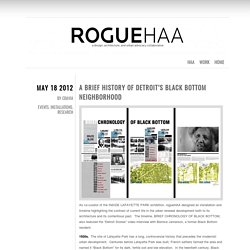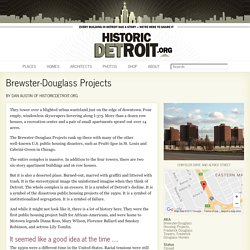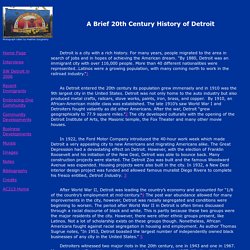

Is downtown Detroit housing market overheating yet? So many new housing developments are coming to greater downtown Detroit that it’s easy to lose track.

Last week alone, four fresh projects with potentially 600-700 units took big steps toward becoming reality. The Michigan Strategic Fund approved incentives for two ambitious ones, in Corktown and in New Center, and the City of Detroit sought proposals from developers to build two more significant projects in Midtown. Those four projects come on top of the 1,000 or so units already under construction around central Detroit in projects such as Orleans Landing and DuCharme Place and perhaps at least 1,000 more units in various stages of the planning pipeline. ►Related:Detroit seeks housing proposals for two Midtown sites ►Related: WeWork co-working spaces coming to downtown Detroit.
A BRIEF HISTORY OF DETROIT’S BLACK BOTTOM NEIGHBORHOOD. As co-curator of the INSIDE LAFAYETTE PARK exhibition, rogueHAA designed an installation and timeline highlighting the contrast of current life in the urban renewal development both to its architecture and its contentious past.

The timeline, BRIEF CHRONOLOGY OF BLACK BOTTOM, also featured the “Detroit Stories” video interview with Bernice Jamerson, a former Black Bottom resident. 1920s. The site of Lafayette Park has a long, controversial history that precedes the modernist urban development. Centuries before Lafayette Park was built, French settlers farmed the area and named it “Black Bottom” for its dark, fertile soil and low elevation. In the twentieth century, Black Bottom became one of the most vibrant African American districts in Detroit. Brewster-Douglass Projects — Historic Detroit. They tower over a blighted urban wasteland just on the edge of downtown.

Four empty, windowless skyscrapers hovering along I-375. More than a dozen row houses, a recreation center and a pair of small apartments sprawl out over 14 acres. History Engine: Tools for Collaborative Education and Research. Detroit in the 1940s - The Atlantic. The early part of the 20th century saw the city of Detroit, Michigan, rise to prominence on the huge growth of the auto industry and related manufacturers.

The 1940s were boom years of development, but the decade was full of upheaval and change, as factories re-tooled to build war machines, and women started taking on men's roles in the workplace, as men shipped overseas to fight in World War II. The need for workers brought an influx of African-Americans to Detroit, who met stiff resistance from whites who refused to welcome them into their neighborhoods or work beside them on an assembly line. A race riot took place over three days in 1943, leaving 34 dead and hundreds injured. A BRIEF HISTORY OF DETROIT’S BLACK BOTTOM NEIGHBORHOOD. Black bottom. Detroit's Black Bottom and Paradise Valley Neighborhoods.
The odd downfall of the school librarian of the year. New York — The path that took Deven Black to his gritty death in a rundown homeless shelter was as baffling as it was tragic.

This was a suburban dad, a nationally recognized school librarian. In just three years, he had become destitute. He had derailed his career with an inappropriate encounter with a female student, had blown up his marriage by giving thousands of dollars to paramours online and had gotten involved in a bank fraud scheme for their sake. Doctors diagnosed depression. Volume of abandoned homes 'absolutely terrifying' Detroit — Detroit has had more homes foreclosed in the past 10 years than the total number of houses in several suburbs — or all of Buffalo, New York.

Since 2005, more than 1-in-3 Detroit properties — 139,699 of 384,672 — have been foreclosed because of mortgage defaults or unpaid taxes, property records show. The vast majority are houses, and the tally is so huge it shocked even those who spent years working on foreclosure in Detroit. "When you see it on a map, it's absolutely terrifying," said Chris Uhl, a vice president of the Skillman Foundation that is working to prevent foreclosures. The Economy: How Under-Confidence Hurts the Economy. Thirty percent of Americans are very fearful that they will lose their job in the next six months.

That is the finding of a recent Marketplace-Edison Research Poll. Over the past 12 months, despite a drop in new jobless claims to a 43-year low, Americans’ anxiety over their personal economic situation has increased sharply. Today, more Americans are afraid of being unemployed than were jobless at the darkest moments of the Great Depression. Many economists will be quick to discount consumer anxious feelings, suggesting workers are being irrational. A Brief 20th Century History of Detroit. Detroit is a city with a rich history.

For many years, people migrated to the area in search of jobs and in hopes of achieving the American dream. “By 1880, Detroit was an immigrant city with over 116,000 people. More than 40 different nationalities were represented…Latinos were a growing population, with many coming north to work in the railroad industry.”1 As Detroit entered the 20th century its population grew immensely and in 1910 was the 9th largest city in the United States. Detroit was not only home to the auto industry but also produced metal crafts, railcars, stove works, paints, iron, brass, and copper.
A brief history of housing in Detroit. Francis M.

Grunow | Tuesday, November 17, 2015 Along with food and water, housing is universally regarded as a basic need. But housing is not basic. In fact, in Detroit, a place which once built housing faster than any other major American city -- and now demolishes housing faster than any other -- housing is quite complicated.